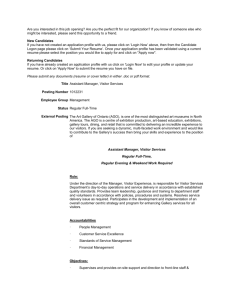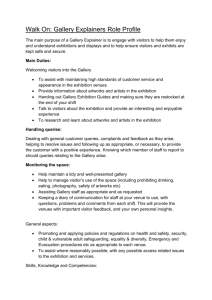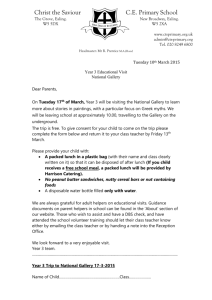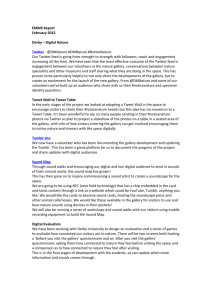Your Tour Summary
advertisement
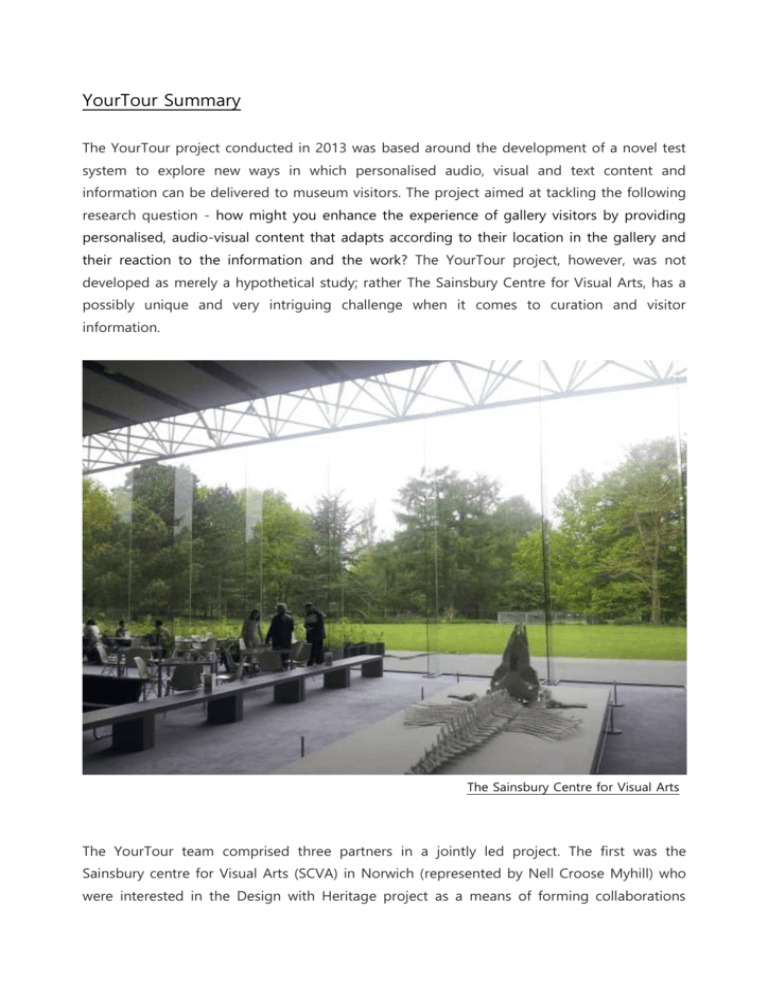
YourTour Summary The YourTour project conducted in 2013 was based around the development of a novel test system to explore new ways in which personalised audio, visual and text content and information can be delivered to museum visitors. The project aimed at tackling the following research question - how might you enhance the experience of gallery visitors by providing personalised, audio-visual content that adapts according to their location in the gallery and their reaction to the information and the work? The YourTour project, however, was not developed as merely a hypothetical study; rather The Sainsbury Centre for Visual Arts, has a possibly unique and very intriguing challenge when it comes to curation and visitor information. The Sainsbury Centre for Visual Arts The YourTour team comprised three partners in a jointly led project. The first was the Sainsbury centre for Visual Arts (SCVA) in Norwich (represented by Nell Croose Myhill) who were interested in the Design with Heritage project as a means of forming collaborations which would allow them to develop research ideas with other professions and resources not easily available to a provincial gallery operating on a limited budget. FACT was another component of the team (represented by Roger McKinley) and had specific interests in the integration of technology in to the heritage institutions sector as part of the Europe wide cross-disciplinary research consortium, ARtsense. The final member of the team was Dr David Scott from the University of Westminster, a research psychologist and an architect with a long running interest in the possibilities of feedback from human experience in spatial design, through the integration of technology. Each of the partners shared an interest in the project as a means for support and the opportunity to develop ideas and work with people from other backgrounds. The Design with Heritage project facilitated this opportunity. The basis of the project was a response to a real life problem faced by the curators at the Sainsbury Centre for Visual Arts. The building and the exhibition were famously designed by Sir Norman Foster. A specification of the exhibition is that only minimal written information can be displayed to accompany the artifacts on display. This reflects the ethos of the design and curation of the display. At the core of this is that the visitor experience is nonlinear and non-prescribed. Visitors are free to make their own connection and discoveries in the gallery by moving between the objects at their own free will and with little to influence their thoughts and opinions of them. The Robert and Lisa Sainsbury Collection has very little labelling, the only information available is the name of the artists, the place of origin, date-or period, acquisition date and object number. There is no interpretative material in the gallery and even the introduction to the Collection is very small and placed outside the gallery itself. This is a model which many galleries are moving towards, most recently Tate Britain who have rehung their permanent collection with only the basic information on the label. Whilst allowing for freedom of audience interpretation and emphasis on letting the objects speak for themselves, the pieces in the collection had a wealth of information behind them, and the gallery wished to keep to the minimalist design aesthetic, whilst somehow incorporating this history and interpretive information. The Sainsbury Centre of Visual Arts was therefore interested to explore ways to share this information without compromising the collections ethos. The YourTour project developed a prototype for a gallery information system, employing a new approach to designing apps or web services suitable for ‘bring your own device’ scenarios. Conventional museum guides lead visitors through a collection on a curated path or offer access to databased content, which can be selected by a visitor. In place of these types of system or others that rely on explicit inputting of information or personal profiles, the YourTour system was designed to use real-time non-invasive monitoring of visitor behaviour to autonomously provide a live stream of location specific content to a tablet device. In place of conventional systems that rely on explicit (and laborious) inputs of personal profiles, the system uses real-time monitoring of visitor behaviour combined with tracking of their location to infer their preferences and potential interests. A content management and delivery system then uses this information to provide individual and adaptive gallery tours. The device keeps track of what objects visitors have been drawn to and provides tailored content to the visitor based on their personal journey around the collection, making connections between objects they have been drawn to during their visit. The working methods of the team were through period design team meetings and coordination centered at UCL. This project was embarked upon with the vision that it could have multiple implications for curators and for how visitors are presented with gallery information, with the potential to make a significant difference to their enjoyment of galleries and exhibitions. Moving forward, the project hopes to have illustrated the merit in further investigation into systems of this type. It is hoped that with further academic support of a future project will lead to a permanent implementation of a system derived from this study in the SCVA. The project developed two test devices along with prototypes of the associated psychophysiological measures and IT systems. A short pilot study was conducted, followed by a more extensive experimental test of the performance of the prototype system in situ. The project team had the permanent collection at the Sainsbury Centre for the Visual Arts available as a suitable and willing test site. The study has had multiple implications for curators and for how visitors use gallery information, with the potential to make a significant difference to their enjoyment of galleries and exhibitions. The Sainsbury Centre for Visual Arts “We want to create a device that will enable us to deliver interpretative material in the galleries to those who want it, as unobtrusively as possible. Taking the approaches used by our guides, and producing and maintaining the ethos of the display- letting the objects speak for themselves, allowing the visitor to make their own connections and associations across the gallery and therefore time and space – to create their own tour. We still want to encourage personal discovery in the gallery, and just as the Sainsbury’s chose objects because of a ‘gut reaction’ or emotional (rather than academic) appreciation of the objects, we hope YourTour will maintain that way of looking, navigating and experiencing the collection. YourTour therefore will allow people to find out more information about the objects they are interested in, I think it is important that there is no predetermined route- it is still the visitor navigating the space on their own terms, with the support of technology to deliver more information when they want it, about things they are interested in.” – Nell Croose Myhill

